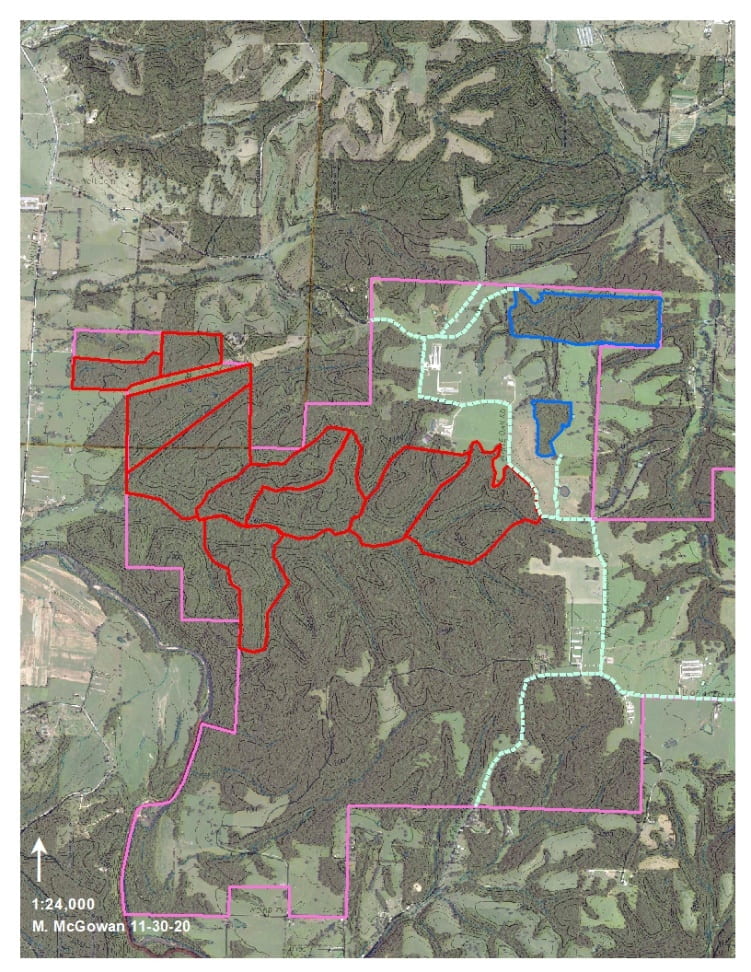Begun as the Beef Cattle Experimental Farm in 1952 with the acquisition of 3,185 acres from the USDA, the work of the unit was targeted to help local farmers transition their idle cotton farms to more diversified opportunities. The Arkansas Agricultural Experiment Station purchased a herd of registered Aberdeen Angus cattle and got a major boost with the contribution of seven champion Herefords in 1953 from F.W. Dye, a leading cattle breeder in northwest Arkansas.
In 1965, the AES swine farm was moved to the Savoy location. In 1991, the first poultry research facilities were constructed at Savoy, and in the mid-1990s, construction of new facilities at the then-named Savoy Beef Research Farm was commenced along with new long-range plans for the development of poultry, swine, and cattle research at the unit.
In 2001, a swine growing and finishing unit was built and the farrowing and nursery units were remodeled. In 2003, AES constructed a broiler/breeder facility designed for research on the genetics and management of broiler breeding stock. Today, the Savoy Research Complex boasts a broiler/breeder research unit, a poultry research unit, a swine research center, a cow/calf research unit, and a stocker cattle receiving and back-grounding research unit.
Source: https://aaes.uada.edu/research-locations/savoy-research-complex/
Goals
The primary objectives for the forest resources at Savoy include:
- Management of upland hardwood forests for multiple objective management
- Multiple objective management on upland hardwood sites is often the best approach for forest landowners. This style of management emphasizes many objectives (timber, wildlife, aesthetics, and others) to maximize benefit from the woodlands.
- Improve overall forest health and productivity
- Forests management to improve health and productivity includes promoting and maintaining desirable species for management. In the case of upland hardwoods, this management is centered around promoting tree species and stand densities suited to the site conditions.
- Improve forest habitat for upland wildlife species
- Management to improve wildlife habitat in upland areas includes thinning, prescribed fire, and maintaining openings or gaps in woodlands.
Savoy is divided into two parts, the Physiological Farm, known as the Phys Farm, and the Station Tract. The Phys Farm, located to the southeast of the station, has about 100 acres of forest, while the Station Tract itself has roughly 2,100 acres of forest. Both tracts are dominated by upland hardwoods.

Fig. 1. An aerial map showing the two parts of the Savoy Research Complex.
Past Management
For a period of time, the forests at Savoy were not harvested with sustainable silvicultural methods and received an aggressive harvest regime in the mid-1990s. AFRC researchers implemented an oak rehabilitation study in the mid-2000s that continues evaluating the impacts of fire and injection. Excepting scattered pockets of timber in the remote corners that were not harvested at that time, very limited merchantable material remains. There are some high-value walnut trees located in Stand E1 which were tagged and recorded in 2010-2011.
 Fig. 2. A detailed view of the management blocks of the Station Tract of forestland at the Savoy Research Complex.
Fig. 2. A detailed view of the management blocks of the Station Tract of forestland at the Savoy Research Complex.
Current Management
A new project at Savoy is scheduled to begin in late 2021. In the northwest corner, one of the few areas which still has merchantable timber, there is enough oak and natural pine in the stand that regeneration is possible with the standard burn-inject-shelterwood method used at LFRS and PTRS. The Forestry Division of the Arkansas Department of Agriculture will be asked to push the fire breaks around the burn areas in late 2021, depending on the Forestry Division’s availability.

Fig. 3. A close-up view of the northwest corner of the Station Tract.
A4, A5, and A7 were burned in winter 2022.
Future Management
The small amount of timber ready for harvest at Savoy, as well as the poor species composition in the remaining overstory on the hard-cut tracts, means that establishing oak seedlings on the ground in larger numbers is the top priority. The next is opening the canopy and controlling competition to allow the desirable oaks to grow and be the crop trees for harvest in 70-80 years. The method for establishing those oak seedlings on an upland hardwood site will be fire.
Fig. 4. Proposed burn blocks at the Savoy Station Tract.
The tracts outlined in red (Fig. 4-4) are proposed burn blocks averaging about 150 acres each. Starting in the northwest corner, the burns will continue in a line to the east. After a burn, there will be a two-year period where seedlings will be allowed to germinate and fuel allowed to accumulate on the forest floor, so that a second burn may be employed if the oak regeneration is not satisfactory. Vegetation control will be employed to knock out midstory competition from undesirable species.
If satisfactory oak regeneration is achieved on the first burn, it will take seven years of prescribed fire. If burning a second time is required to get oak regeneration, it could take a decade or more to get the forest ready for oak management.
The cost and management of a 200-acre fire may require further halving these stands, resulting in a 14-year timeline. Regardless, it will likely be two decades or more before regular timber harvests can be scheduled.
In 2023, ~15 acres of scrub vegetation was cleared from the Phys Farm site to create new pastures for cattle research. Another 10-15 acres is to be cleared in 2024 for the same purpose.
